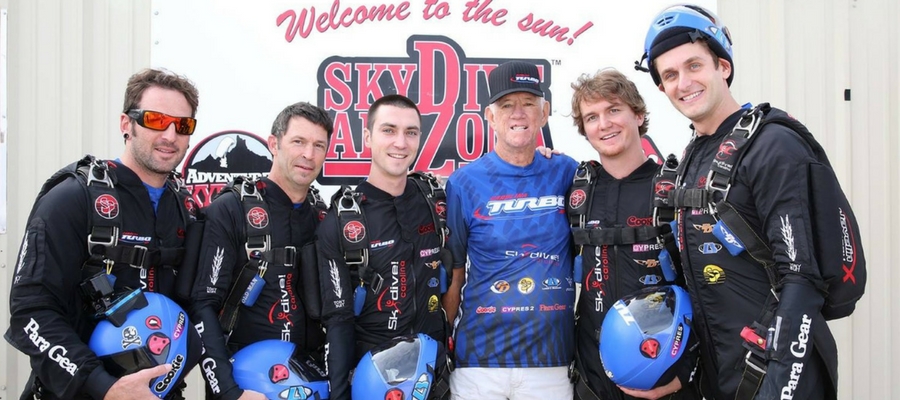So You Want to Be on a Skydiving Team?
Skydiving
8 years ago
Are You Ready to Join a Skydiving Team?
As a skydiver, there is nothing more inspiring than watching skydiving teams take their place on National or World podiums. It’s easy to be seduced by the logoed jumpsuits, matching gear, and camaraderie of a team and daydream that it could be YOU standing on the podium with cheers and accolades from fellow jumpers. If it’s your dream to experience this glorious moment one day, it’s important to know that there’s much more than meets the eye to make it possible.
Here are some important things to consider if you’re ready to join a skydiving team:

Passion
First, you yourself must be incredibly passionate about skydiving because being on a team is a mental, physical and financial commitment. If you’re not thinking about skydiving every waking second, dreaming of perfecting moves, looking up in the sky daydreaming of what’s happening on the DZ on your morning commute, then you may want to reconsider your goals in skydiving.
Teammates
Skydiving is an intimate sport. You spend more time on the ground than you actually do in the sky. Therefore, it is incredibly important to be on a team with people you get can along with, accept criticism from, joke around with, and be motivated by to be better for the sake of the team as a whole.
Airspeed, one of the longest running FS teams in history, is more concerned with personality than skill. They understand that skills can be developed, but personalities don’t tend to change. Airspeed constantly keeps their eye out for people that may be a potential fit as next members of the team. When the time comes, they hold tryouts as it’s a great way to see if they’ll get along spending time and working out dives together.
Commitment
No matter what kind of team you embark on, commitment is key. If you know what the end goal is, it’s easier to map out what the exact commitment is. Since competing at Nationals is a common team skydiving goal, we’ll cover that here to help breakdown commitment goals:
Commitment is easiest to map out by working backward. What IS the end goal? Just to experience competition? To improve your own skills? Advance to another class? Win?
Once you’ve outlined your goals, you can determine the following:
- How many jumps to commit to team training for the season?
- How many coaching camps from a professional?
- How much tunnel time to commit?
- How many local, regional, sky or tunnel competitions to attend?
- Do you want to travel for coaching, tunnel time or competitions?
- If so, how much is airfare, hotel, car rental, event registration?
Finances
The next step is to budget to see if you can financially afford these goals. It is crucial that you have teammates that can responsibly hold up their end of the goals. It would halt the team if someone mid-season backed up because they didn’t realize how expensive everything would be.
After you consider the costs, it’s wise to go back to the goals and adjust if necessary so the team can fit the goals into each person’s financial needs.
Schedule
Balance is key. If you’re passionate, it’s easy to want to train 24/7. However, the key is not to burnout. This gives you needed space between members to do your own thing whether it’s fun jumping outside of the team, having fun in the tunnel cross-training, maintaining work to fund jumps, or just relaxing. It’s important to create a schedule of how many jumps you want to commit to, leaving space for those other personal needs.
Train Like An Athlete
There are many nay-sayers that say skydiving isn’t a sport. However, an athlete is defined as “a person trained or gifted in exercises or contests involving physical agility, stamina, or strength; a participant in a sport, exercise, or game requiring physical skill.” There is also a saying in skydiving that “Skydiving is 90% mental, and 10% physical.” Physical fitness [outside of skydiving] prepares the body to cope with certain stress, increases energy levels and overall awareness – all of which are key characteristics that benefit a skydivers performance.
Athletes also use visualization, a key mental training tool for skydiving competitors. In fact, in skydiving, the mental preparation requires more training, focus and discipline than the physical part. However, both mental and physical attributes help make you a better overall skydiving athlete.
Communicate
This is a key element in a team’s success that is often overlooked. If you are on a team where everyone is at a similar skill level and no one has ever competed before, it’s hard to define who the leader is. Everyone’s experience varies and there’s a TON of information online, so it’s important to decide roles.
Some teams pick a different leader for each training camp. That person is designated to schedule what time to meet, handle manifesting, and lead debriefs. That way each person gets an opportunity to be in the leadership role and members have an opportunity to learn from each other.
Other teams schedule a “pass the rock” to air out any bad vibes from a training day, or just to update and check in with each other as a team.
Bottom line, you were either chosen or you chose a person to be a part of the team. It’s important to maintain that relationship, not to get caught up in any “he-said, she-said”, and get to the basics: c-o-m-m-u-n-i-c-a-t-e.
Have Fun!
This is IMPORTANT! Many teams that have decided to commit to a team stop fun jumping altogether! It’s essential to remember why we started this sport – and it was to have fun! Be sure to do fun jumps as a team AND individually, travel to boogies, and stay in love with the sport that brought your team together.




